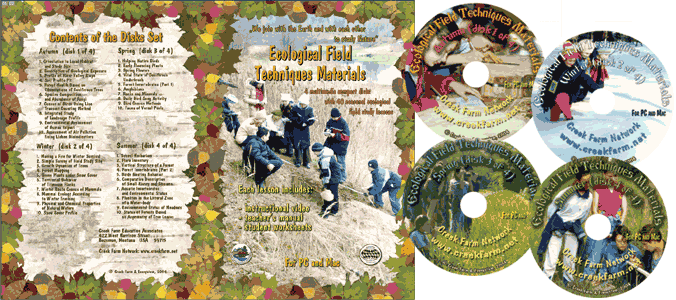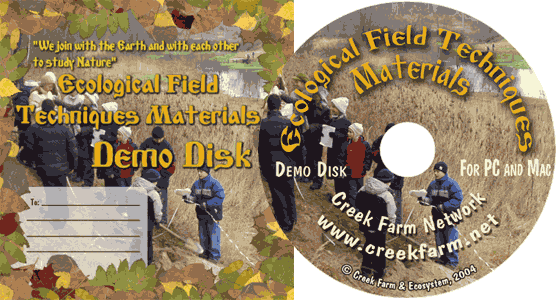|
| Our Field Ecology Center published more than
180 methodical materials for nature studies. Some of them are in English: |
|
|
|
Study of Plankton
© Alexsander S. Bogolyubov,
Aleksey A. Kotov, Russia, 1999
© Michael J. Brody, USA,
2003
 This manual contains procedures for
studying meso- and microzooplankton in freshwater bodies, including techniques of
sampling, sample conservation, qualitative and quantitative analyses. Emphasis is on long
term studies using identical field study techniques. Variations and options for additional
studies are described. This manual contains procedures for
studying meso- and microzooplankton in freshwater bodies, including techniques of
sampling, sample conservation, qualitative and quantitative analyses. Emphasis is on long
term studies using identical field study techniques. Variations and options for additional
studies are described.
This field study has instructional video
featuring real students conducting the ecological field techniques in nature. Each video
illustrates the primary instructional outcomes and the major steps in accomplishing the
task including reporting the results.
Introduction
The zooplankton community is one of the main components of water-body biocenosis.
The term УplanktonФ comes from the Greek word meaning Уhover.Ф
Thus, zooplankton is a group of rather small animals drifting in the water column.
Plankton is abundant in lakes, ponds and reservoirs. Its biomass and populations are
significantly lower in rivers.
The zooplankton community, as any other community in an ecosystem, is characterized by
a constancy of species diversity, dynamic stability and a certain structure peculiar to
the plankton community.
Change in water conditions causes changes in the proportions of plankton and other
water animals. Sometimes it is possible to make a conclusion on the possible cause of
changes, based on their analysis: excessive increase of fish populations, changes in the
chemical composition of water (for instance, acidification), and so on. That is why long-term
and repeated (in the course of a year) observations of plankton are of particular
interest in ecological studies.
Most procedures for assessing any parameters of a body of water based on a single
series of sampling do not stand up to critique. For example, if you go to the Sahara
desert in spring and carry out a one-time survey, then you can make a conclusion that
environmental conditions in the region are favorable for fruit growing: it is very warm
there in spring and there is enough moisture. However, a dry season will come in a month
and the desert will become barren.
Thus, studies of plankton that have been conducted within a week are of no interest to
scientists: they provide information only on the given week of the year, but they do not
give an idea of the structure and functioning of the community as a whole.
Long-term studies should be carried out in the course of a long period of time and
according to the same technique, otherwise, results of studies obtained in different years
cannot be compared and variability trends cannot be revealed.
Techniques for plankton collection
It is ideal to collect and count the individual plankton animals. This is rather
difficult due to the large differences in their sizes: from 20 microns to several
millimeters. This manual describes methods for census of mesoplankton (1mm and
larger), which include Daphnia, Polyphemus and others, and microplankton
(50 Ц 1000 microns) Ц larvae of Copepods (nautilus and copepodites),
water fleas Bosmina, Diaphanosoma, and rotifers. The sampling method
depends on the type of water body, its depth and size.
Sampling with the help of a plankton net
Construction of a plankton net. A plankton net is a net made of a special cloth
called Уplankton gauze,Ф which lets water pass, but collects plankton. The net also
has a container to collect animals that are accumulated in the course of sampling
(filtering) (Picture 1a).
The plankton net can be homemade. You will need a mill sieve (with cells of 0.15 Ц
0.1 mm), several pieces of wire, tight cloth and a plankton glass (Picture 1b).
You can use parachute kapron instead of Уplankton gauze,Ф but do not use cotton
medical gauze as it is too soft and it has cells that are too big.
The cloth is cut out in the form of a cone and sewn to a metal hoop at its upper part
and to a plankton glass at its lower part. In both cases, the УgauzeФ should not be
sewed directly to the hoop or glass, but to a band of cloth (flax, coarse calico or
cotton), otherwise it will be too easily torn where it joins together.
Two standard size plankton nets are used in hydrobiological monitoring Ц with a
diameter of the inlet Ц 25 or 40cm and length of the cone Ц 55 or 100cm
correspondingly.
A commercial plankton glass can be replaced...
This was only the first page from the manual and its full version you can see in the
Ecological Field Studies Techniques Video 4CD Set:
It is possible to purchase the complete set of 40 seasonal Ecological Field
Studies Techniques Video (in mpg format) in an attractive 4 compact disk set.
These compact disks are compatible with Mac and PC computers.
The videos are suitable for individual student or whole class instruction. To purchase the complete 4CD set
write to ecosystema1994@yandex.ru in a free form.

Ecological Field Studies Demo Disk:
We also have a free and interesting demonstration disk that explains our ecological field studies approach.
The demo disk has short excerpts from all the seasonal field study videos as well as sample text from all the teacher manuals.
The disk has an entertaining automatic walk through which describes the field study approach and explains how field studies meet education standards.
You can also download the Demo Disc from ecosystema.ru/eng/eftm/CD_Demo.iso.
This is a virtual hybrid (for PC and Mac computers) CD-ROM image (one 563 Mb file "CD_Demo.iso").
You can write this image to the CD and use it in your computer in ordinary way.
You also can use emulator software of virtual CD-ROM drive to play the disk directly from your hard disk.

|







